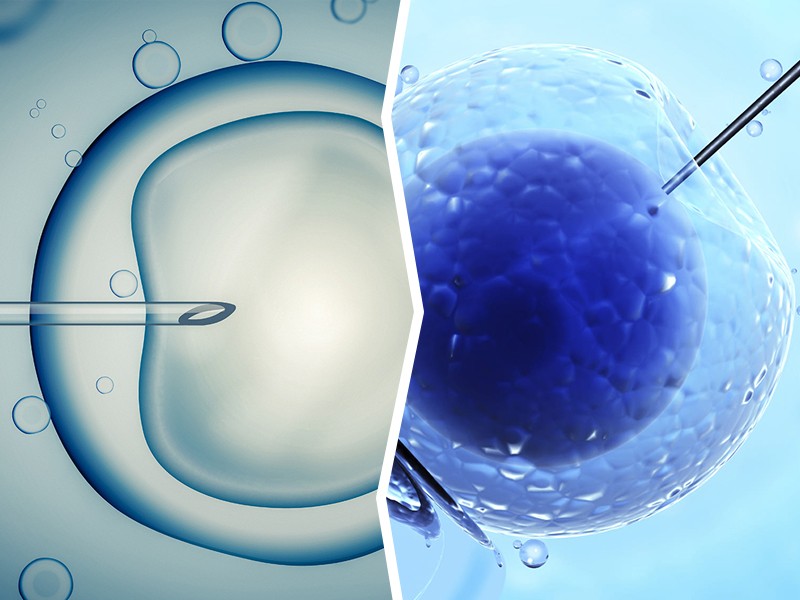Difference between IVF and IUI

The number of infertile couples in the world is growing. The number of marriages that cannot have children ranges from 8 to 25%. This number has not decreased in recent years. In most European countries, about 10% of couples are infertile, in the USA – from 8 to 15% (depending on the state), in Canada – about 17%, in Australia – more than 15%.
According to the definition of the World Health Organization (WHO), an infertile married couple is one where a woman can’t get pregnant for 12 months, with regular sexual activity (2-3 times a week) without using contraception and being in childbearing age.
At the same time, there can be both male and female factors with almost equal frequency, and both of these factors are also often found.
Different methods of treatment are used for different diseases. One of the most successful are in vitro fertilization (IVF) and intrauterine insemination (IUI).
What is it?
IVF – in vitro fertilization (in vitro fertilization, artificial insemination), an auxiliary method of fertilization. An egg is taken from a woman and sperm is taken from a man and combine outside the body. Then the fertilized egg is implanted into the woman’s uterus.
IUI – intrauterine insemination. This is a method of artificial insemination, which is suitable if there is a pathology on the part of a man. The point of this procedure is as follows: Doctor selects the most active and healthy spermatozoids from a man’s sperm in the laboratory and helps them to overcome the path through the cervix straight to the egg cell.
Differences between IVF and IUI
Although these two methods belong to artificial insemination, they differ in many ways. Diagnoses for which they can be used, the procedures, contraindications and of course, the probability of getting pregnant. And now we will analyze these methods and the difference between them in details.
Diagnoses, for which they are used
IVF is most often prescribed for problems with female infertility due to the following diagnoses:
- Tubal infertility – obstruction of the fallopian tubes or their absence
- Sever endometriosis – after medical and surgical treatment
- Endocrine disorders, if the treatment was carried out more than 2 years and was ineffective
- Polycystic ovary disease
- The presence of sperm-reacting antibodies in a woman’s body (Immunological feature of the body)
- Infertility, for an unexplained reason, when the diagnostic indicators are normal, and pregnancy doesn’t occur
This method is also suitable for male infertility for the following reasons:
- Low sperm activity
- Low sperm count in semen
In turn, IUI is indicated for male infertility and / or for minor problems of women. Indications include the following diagnoses:
By the man side
- More often, the procedure is prescribed for couples in which the man has the cause of infertility
- Sperm subfertility – too law amount of qualitative sperm for fertilization
- Ejaculatory-sexual disfunction – lack of ejaculation
- Hypospermia – a small amount of ejaculate
- Azoospermia – complete absence of sperm in the semen
- Injuries or chronic diseases of the male genital organs
By the woman side
- Cervical factor of infertility – when the cervix is not able to pass sperm due to trauma, surgery, polyps, deformities
- Vaginismus – a spasm of the vaginal muscles, which occurs involuntarily when there is a fear of sexual intercourse
- Sperm allergies
- Absence of cervix – as a result of past diseases
- Endometriosis
The procedure
The next difference will be in the procedure. The in vitro fertilization procedure is more difficult, lengthy, invasive, and the fertilization itself is completely controlled by doctors. Therefore, it is considered less natural, since the doctor fertilizes the egg in the laboratory.
IVF includes the following stages:
- Controlled ovarian stimulation
- Puncture and collection of egg cells
- Receiving and preparing male sperm
- Fertilization in the laboratory
- Placing the embryo in the uterus
- Pregnancy support until childbirth
The intrauterine insemination protocol is less invasive and is considered a more natural, but also an artificial way of getting pregnant.
Stages of intrauterine fertilization:
- Sperm collection outside of intercourse;
- Selection in laboratory conditions of full-fledged spermatozoids
- With the help of a special catheter, sperm is injected into the uterus;
- Pregnancy control;
Contraindications
Since both methods are artificial insemination, they have several common contraindications, such as acute infectious diseases, mental disorders and oncological diseases of any localization. But also, there are differences in contraindications.
So IUI cannot be carried out:
- With disease or absence of fallopian tubes
- Polycystic ovary disease
- All male sperm are pathological
- After 4-5 attempts at unsuccessful IUI attempts
- The presence of sperm-reacting antibodies in a woman’s body
There are not many contraindications that apply only to IVF. They are all tied to stages:
- Chronic endocrine diseases in a severe stage – during ovarian stimulation, there may be an exacerbation
- Lack of ovarian response to stimulation
The effectiveness of the method
Also, these methods are distinguished by their effectiveness. So the percentage of successful procedures for IUI is about 20-25%. IVF, in turn, gives a 35-55% chance of getting pregnant. But for every couple, the chance will be different. Since both of these methods have so many factors that will affect the success, these are: the age of the couple, test results, health conditions, the number of attempts which were done before. It is important that if the first attempt was unsuccessful, then it is worth continuing further. The doctor draws conclusions from the previous procedure and makes adjustments, and the next attempt may work out. It is also worth noting that the cost of the IUI procedure is much lower than that of IVF, which is due to the peculiarities of the in vitro fertilization procedure.
It is also important to take into account that the fertility treatment method is offered by a fertility doctor. After passing all the tests, consultations of related doctors, examination of a woman and a man, he tells which methods can be applied to a specific couple, arguing his position. Sometimes it happens that both procedures are possible, and then the choice is already up to the spouses. Therefore, the method should be chosen only after a complete study.


